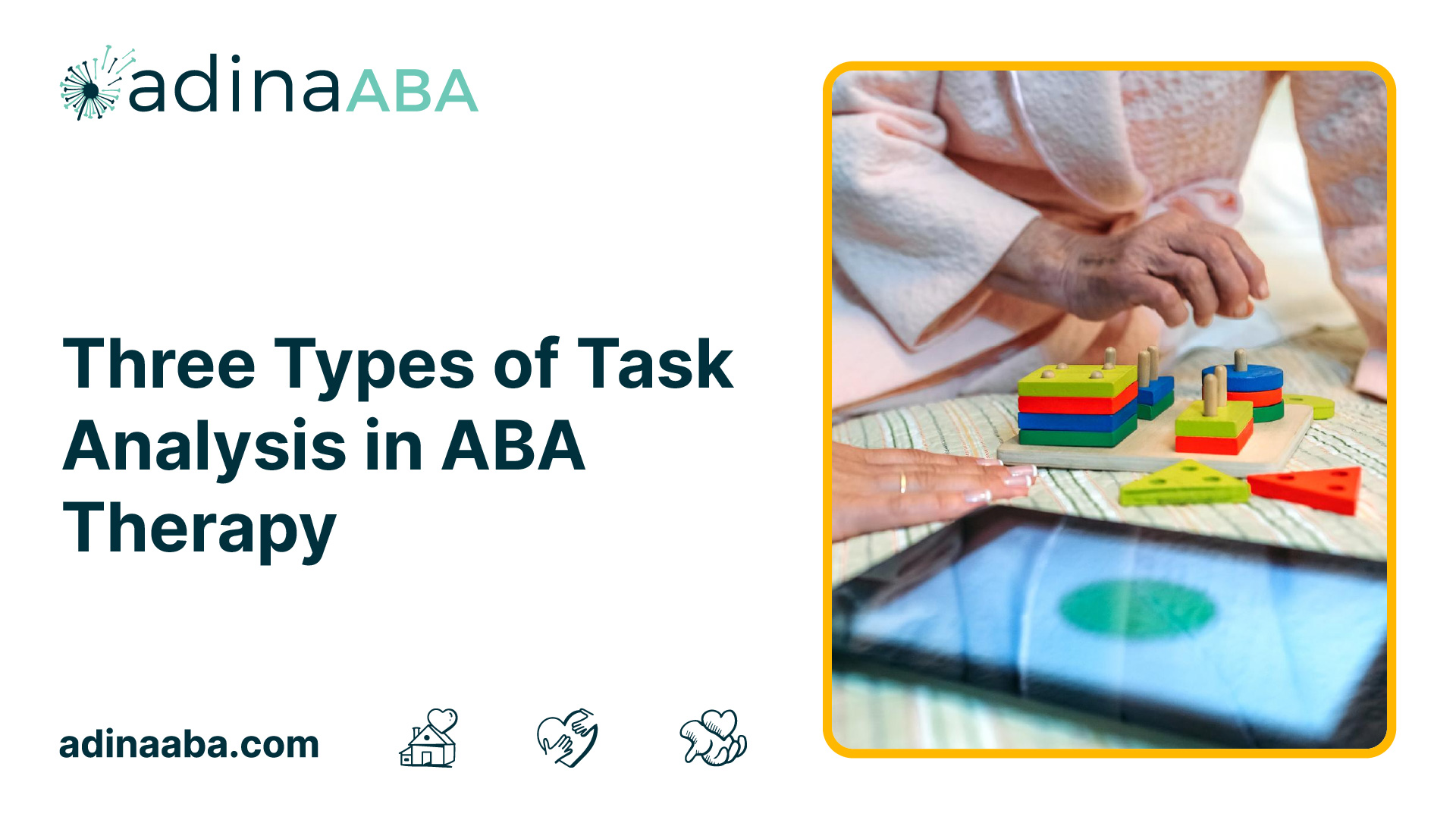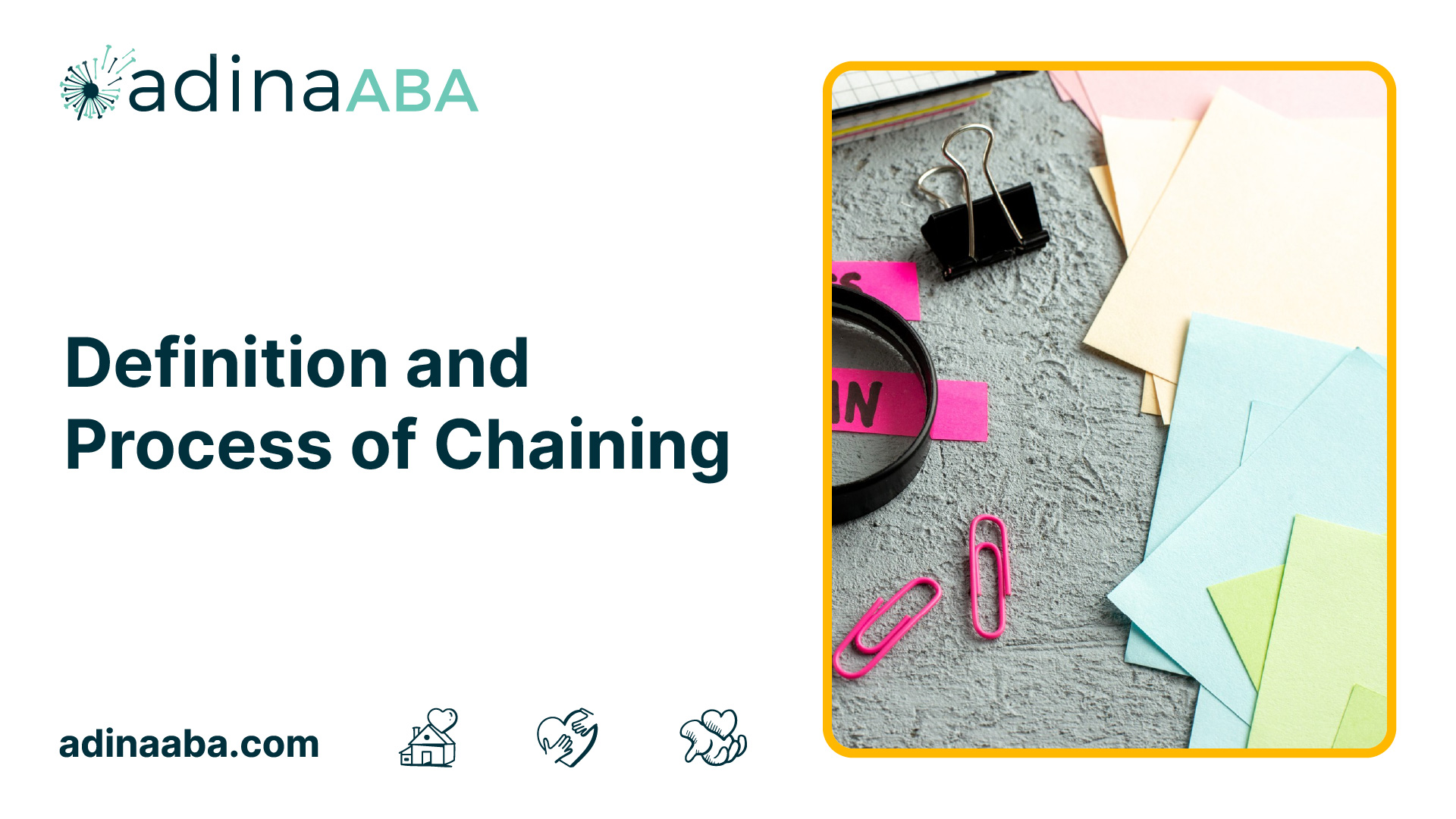Three Types of Task Analysis in ABA Therapy

Understanding ABA Therapy
ABA therapy, or Applied Behavior Analysis therapy, is a scientifically based and widely recognized approach used to help individuals with autism spectrum disorder (ASD) and other developmental disabilities. ABA therapy focuses on understanding and modifying behavior by applying principles of behavior analysis.

What is ABA Therapy?
ABA therapy is a systematic and evidence-based approach that aims to improve socially significant behaviors. It involves breaking down complex skills into smaller, more manageable components in order to teach and reinforce desired behaviors. ABA therapists use data collection and analysis to assess progress and make data-driven decisions.
ABA therapy can be implemented in various settings, such as schools, clinics, and homes. It is often individualized to meet the specific needs of each individual receiving therapy. The ultimate goal of ABA therapy is to increase functional skills, promote independence, and enhance the overall quality of life for individuals with autism and other developmental disabilities.
Importance of Task Analysis in ABA Therapy
Task analysis plays a crucial role in ABA therapy as it allows therapists to systematically teach new skills and break down complex tasks into smaller, more manageable steps. By breaking down skills, individuals can learn and master each step before moving on to the next, ensuring a solid foundation for skill acquisition and generalization.
Task analysis provides a clear roadmap for both therapists and individuals receiving therapy, making the learning process more structured and effective. It helps identify specific targets for intervention, enables the measurement of progress, and facilitates the identification of areas that may require additional support or modifications.
In ABA therapy, task analysis is used to teach a wide range of skills, including academic, self-care, communication, social, and play skills. By breaking down these skills into smaller components, therapists can provide targeted instruction, reinforcement, and prompt fading to promote skill development and independence.
Overall, task analysis is a fundamental component of ABA therapy, allowing therapists to systematically teach and reinforce desired behaviors while promoting skill acquisition and independence. Through the use of task analysis, individuals receiving ABA therapy can maximize their progress and achieve meaningful outcomes.

Types of Task Analysis
Task analysis is a fundamental component of Applied Behavior Analysis (ABA) therapy. It involves breaking down complex skills or tasks into smaller, more manageable steps to facilitate learning and skill acquisition. In ABA therapy, there are three main types of task analysis: chaining, forward chaining, and backward chaining.

Chaining
Chaining is a task analysis technique that involves teaching a sequence of steps or behaviors to achieve a specific goal. It is particularly useful when teaching complex skills that consist of multiple steps. Chaining can be implemented in different ways, depending on the individual's learning needs and the nature of the task.
Forward Chaining
Forward chaining is a task analysis method where the therapist or instructor begins by teaching and reinforcing the first step in a sequence of behaviors. Once the individual has mastered the first step, the second step is introduced and linked to the first step. This process continues until the entire sequence of behaviors is learned.
Forward chaining allows the learner to experience success early on in the task, which can increase motivation and engagement. It also provides an opportunity for immediate reinforcement, as the learner receives reinforcement after completing each step, leading to a sense of accomplishment.

Backward Chaining
Backward chaining, on the other hand, involves starting with the final step of a task sequence and working backward. The therapist or instructor initially completes all the steps except for the last one. The individual is then prompted and guided through the second-to-last step, with subsequent steps completed by the learner. This process continues until the individual can independently perform the entire sequence.
Backward chaining allows individuals to experience the satisfaction of completing the task independently, as they are responsible for the final step. It can also be helpful for tasks that require a specific end result, as the individual has the opportunity to practice and refine the final step consistently.
To better understand the differences between these types of task analysis in ABA therapy, the following table provides a brief comparison:
By utilizing these different types of task analysis, ABA therapists can effectively teach and reinforce skills in a systematic and structured manner, promoting learning and progress for individuals receiving ABA therapy.

Chaining in ABA Therapy
Chaining is a fundamental technique used in Applied Behavior Analysis (ABA) therapy to teach individuals new skills or behaviors. It involves breaking down complex tasks into smaller, manageable steps to facilitate learning and promote skill acquisition. There are three types of task analysis used in ABA therapy: chaining, forward chaining, and backward chaining. In this section, we will focus on chaining in ABA therapy.

Definition and Process of Chaining
Chaining is a task analysis method that involves teaching a series of individual steps and linking them together to form a complete task or behavior. It can be utilized for a wide range of skills, from simple daily activities to more complex behaviors. The process of chaining typically involves the following steps:
- Task Analysis: The behavior or skill is analyzed and broken down into its component steps. Each step is identified and defined to ensure a clear understanding of the overall task.
- Task Presentation: The steps of the task are presented to the individual in a systematic and sequential order. The therapist or instructor models and guides the individual through each step, providing prompts and support as needed.
- Task Reinforcement: Reinforcement is provided after the completion of each step to encourage the individual and reinforce correct performance. This can include verbal praise, tokens, or other preferred rewards.
- Task Integration: As the individual becomes proficient in performing each step, the steps are gradually linked together to form the complete task or behavior. The individual is encouraged to perform the steps independently, with fading prompts and support from the therapist.

Benefits of Chaining in ABA Therapy
Chaining offers several benefits in ABA therapy, making it an effective technique for teaching new skills and behaviors. Some of the key benefits of chaining include:
- Task Mastery: By breaking down complex tasks into smaller steps, chaining allows individuals to focus on mastering one step at a time. This incremental approach promotes a sense of accomplishment and builds confidence as they progress through the steps.
- Error Reduction: Chaining helps to minimize errors by providing clear and structured guidance during the learning process. By teaching each step individually and reinforcing correct performance, individuals are more likely to learn and maintain the correct sequence of steps.
- Generalization: Chaining promotes generalization, which is the ability to apply learned skills across different settings, materials, or people. By gradually linking the steps together, individuals learn to perform the complete task in various contexts, increasing their ability to generalize the skill.
- Independence: Chaining aims to promote independent functioning by gradually fading prompts and support. As individuals become proficient in each step and gain confidence, they are encouraged to perform the task or behavior independently, fostering greater independence and self-reliance.
Chaining is a versatile and effective task analysis technique used in ABA therapy to facilitate skill acquisition and promote independence. By breaking down complex tasks into manageable steps and linking them together, individuals can learn and perform new skills with greater ease and confidence.
Forward Chaining in ABA Therapy
Forward chaining is one of the three types of task analysis commonly used in Applied Behavior Analysis (ABA) therapy. It is a systematic approach that breaks down complex tasks into smaller, manageable steps. This section will explore the definition and process of forward chaining, as well as its application and effectiveness in ABA therapy.

Definition and Process of Forward Chaining
Forward chaining involves teaching a task by initially prompting and reinforcing the individual to complete the first step of the task independently. Once the first step is mastered, the therapist or instructor then provides assistance and reinforcement for the individual to complete the first and second steps independently. This process continues, with additional steps being added as the individual becomes proficient at each preceding step.
Application and Effectiveness in ABA Therapy
Forward chaining is particularly useful when teaching tasks that have a clear sequential order, such as getting dressed, making a sandwich, or brushing teeth. By starting with the first step and progressively adding subsequent steps, individuals with developmental disabilities can develop the skills needed to carry out complex activities independently.
This method allows individuals to experience success early on, as they are prompted and reinforced for completing the initial steps. It also helps to maintain motivation and engagement throughout the learning process. By breaking down tasks into manageable components, forward chaining enables individuals to build a solid foundation of skills that can be generalized to other areas of their lives.
Moreover, forward chaining allows therapists and instructors to pinpoint specific areas where an individual may need additional support or instruction. By focusing on one step at a time, they can tailor their teaching strategies to address any difficulties or challenges that may arise.
In summary, forward chaining is a valuable technique within ABA therapy that helps individuals acquire new skills by systematically breaking down complex tasks. By gradually adding steps and providing prompts and reinforcement, individuals can progress towards independent task completion. This method promotes learning, confidence, and generalization of skills, ultimately empowering individuals to maximize their potential.

Backward Chaining in ABA Therapy
Backward chaining is one of the three types of task analysis commonly used in Applied Behavior Analysis (ABA) therapy. This technique involves breaking down a complex task into smaller, manageable steps and teaching them in reverse order. By starting with the last step and gradually working backward, individuals receiving ABA therapy can develop the necessary skills to complete the entire task successfully.

Definition and Process of Backward Chaining
In backward chaining, the therapist initially completes all but the last step of the task, providing prompts and guidance as needed. The individual receiving therapy then performs the final step independently. This process continues with the therapist fading prompts and gradually allowing the individual to complete more steps independently until they can successfully perform the entire task without assistance.
Backward chaining is particularly effective for tasks that have a clear and motivating end result, as individuals often find it reinforcing to complete the final step independently. It allows them to experience success early on and gradually build confidence as they master each preceding step.
Utilization and Impact in ABA Therapy
Backward chaining has proven to be a valuable technique in ABA therapy, providing several benefits for individuals with various skill development needs. By breaking down tasks into smaller, more manageable components, backward chaining helps individuals develop a sense of mastery and achievement. It also allows them to focus on learning specific steps while reducing the risk of frustration or overwhelm.
Moreover, backward chaining is especially useful for tasks that require a sequence of steps, such as getting dressed, brushing teeth, or making a sandwich. By starting with the final step and working backward, individuals can better understand the logical progression of the task.
To illustrate the process and impact of backward chaining, here is an example of teaching a child to tie shoelaces using this technique:
By gradually fading prompts, the child gains independence in each step until they can tie their shoelaces entirely on their own.
Overall, backward chaining is a valuable tool in ABA therapy as it provides a structured and systematic approach to skill development. By allowing individuals to experience success early on and gradually building their abilities, backward chaining fosters confidence, independence, and the acquisition of new skills.
Sources
More Resources
Expert Clinicians
Get started today ->

.jpg)
.jpg)
.jpg)


.jpg)